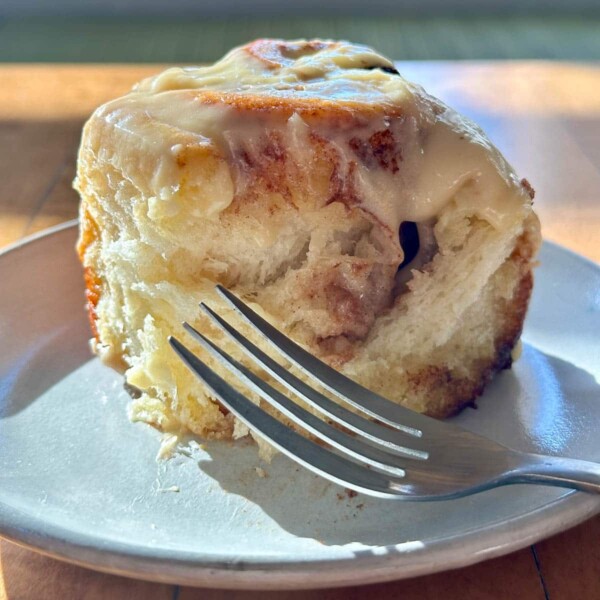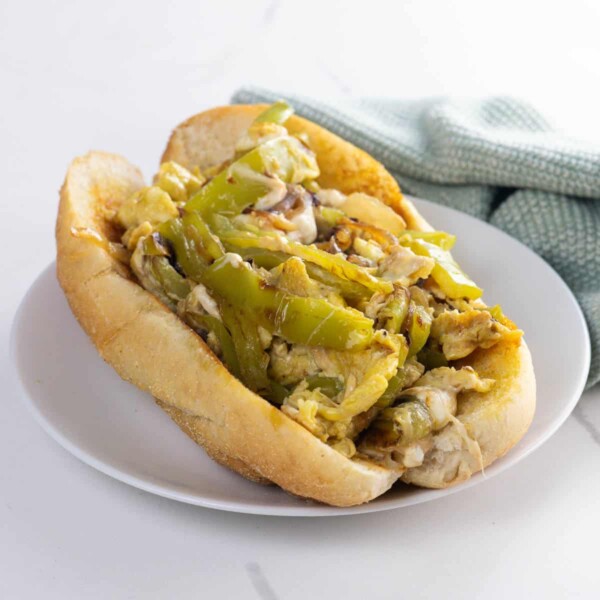This post may contain affiliate links. Learn more.
Easy shakshuka with feta is one of our favorite ways to have eggs for dinner, and it’s equally great for brunch. It’s a quick, easy, one-pan meal that’s full of comfort and flavor.
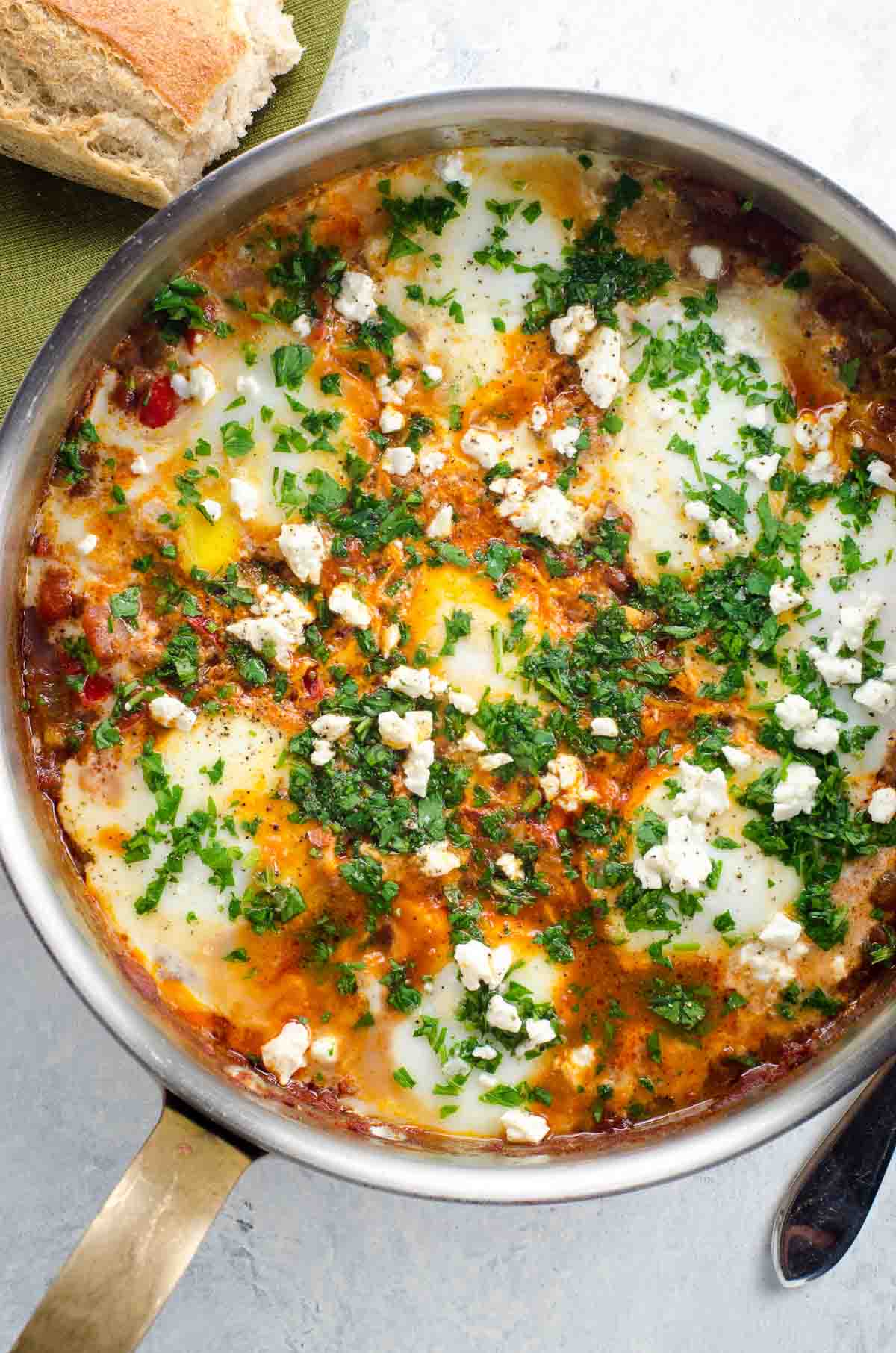
Why we love this recipe
Shakshuka is world-class easy comfort food. It comes together quickly, and you can even make the sauce in advance if you like. Chez Cope, we don’t always eat shakshuka, but when we do, we usually eat it for dinner. That said, it makes a fabulous brunch or breakfast too.
This version has tons of flavor (whether or not you add the feta), and it’s got a satisfying amount of heat without being too spicy.
What is shakshuka?
Shakshuka (sometimes spelled shakshouka) is a savory dish of eggs poached in a tomato stew typically flavored with onions, red peppers, garlic, cumin, and other spices.
Theories of shakshuka’s precise origin vary, with possible roots in Morocco, Tunisia, Ottoman Turkey, and Yemen. For a long time, shakshuka has been served in many households throughout the middle east and north Africa.
More recently, thanks in part to the popularity of culinary giants like Ottolenghi and Zahav, shakshuka has proliferated more widely throughout the world.
As is true of many Middle Eastern foods, shakshuka is a real indication of historic migration and also, I like to think, of how similar we all are despite the many ways in which we sometimes put our differences first.
What you’ll need
Here’s a glance at the ingredients you’ll need to make this recipe.
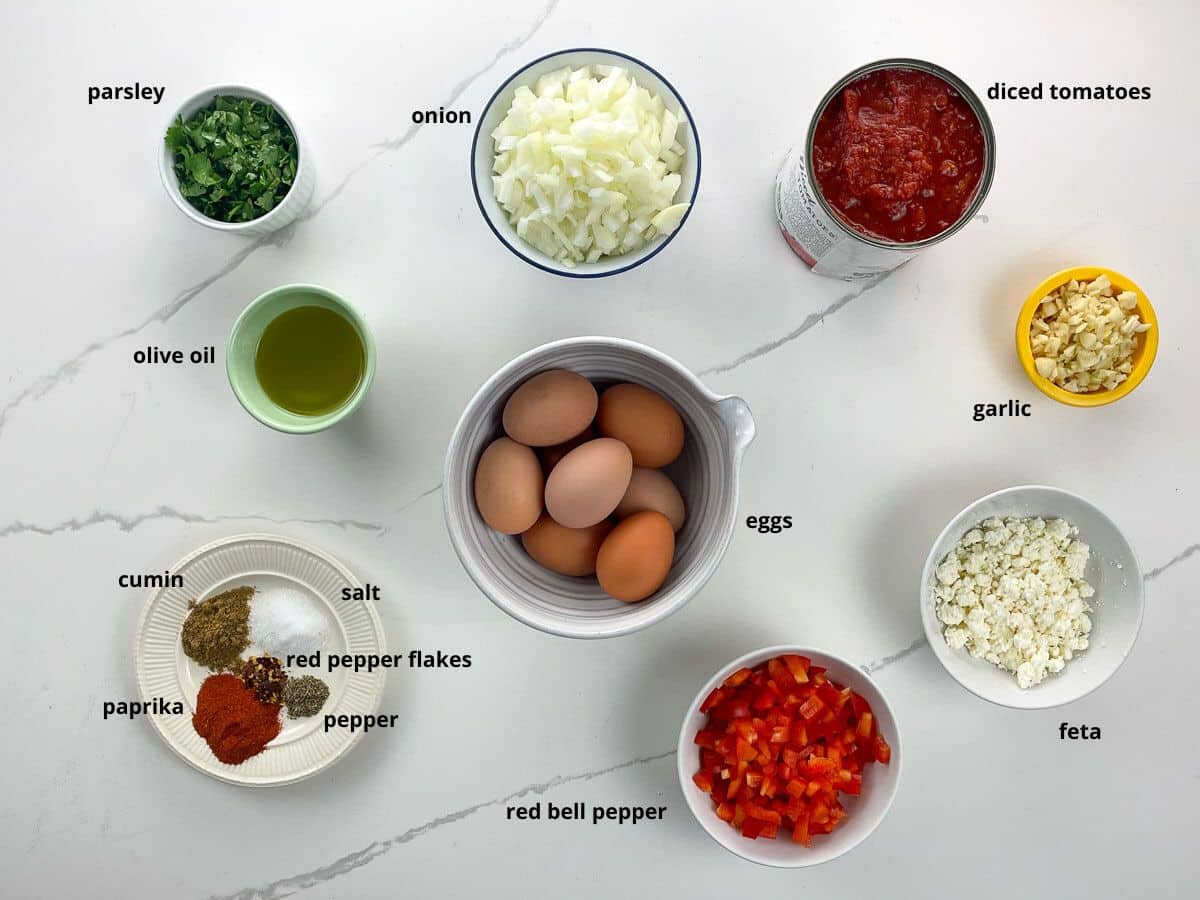
For the sauce
- A good old yellow onion works great here, but this is not a fussy recipe. You can swap in a red onion or a couple of shallots if that’s what you’ve got on hand. Dice it nice and small so it almost melts into the sauce. I aim for 1/4-inch (smaller for shallots).
- You can use red, orange, or yellow bell pepper for this recipe. I like to use red when I have it, just because the color melts into the tomato sauce. Their flavors are basically indistinguishable. Dice the pepper nice and small, too.
- The recipe calls for a fair amount of garlic, and you can add more if you like — I often do. Chop it evenly but somewhat roughly (as opposed to mincing), so that it won’t burn.
- The sauce packs a deep savory flavor from a combination of ground cumin, paprika, and red pepper flakes. As written, this recipe has a very mild heat. You can add more red pepper flakes to suit your preference.
- You can use one 28-ounce can or one 26.5-ounce box of diced tomatoes (sometimes sold as chopped tomatoes), including all their juices. Different brands vary in consistency — the liquid may be thinner or thicker. They’ll all work just fine. If your brand is on the thicker side, you may want to simmer the sauce with a lid on to prevent further thickening, and perhaps even add a little bit of water before doing so. Simmer for the full time period regardless, so the flavors have a chance to bloom. The goal is to end up with a sauce thick enough to allow you to create divots for the eggs.
To finish the dish
- Good-quality eggs with beautiful golden yolks make this recipe the best version of itself. How long to cook them is a matter of personal preference — keep in mind that they will continue to firm up a bit as they sit in the hot pan. I prefer the whites set and the yolks a bit runny.
- I like to use a mild, cow’s milk feta that crumbles well and isn’t too soft. In this case, you can add it to the sauce right before or right after you put in the eggs. With softer varieties, you may want to add them at the end, right before sprinkling on the herbs. You can leave the cheese out and still end up with a beautifully flavored dish. Or try substituting fresh goat cheese for another great variation.
- I like to use chopped fresh cilantro when we have it, for a big burst of freshness and flavor. Flat-leaf (Italian) parsley works well too, if you prefer. If I have scallions in the fridge, I’ll often slice a couple and add them as well.
How to make it
Here’s an overview of what you’ll do to make a dreamy, satisfying batch of shakshuka with feta. You can see the steps in action in the video that accompanies this post, and get all the details in the recipe card below.
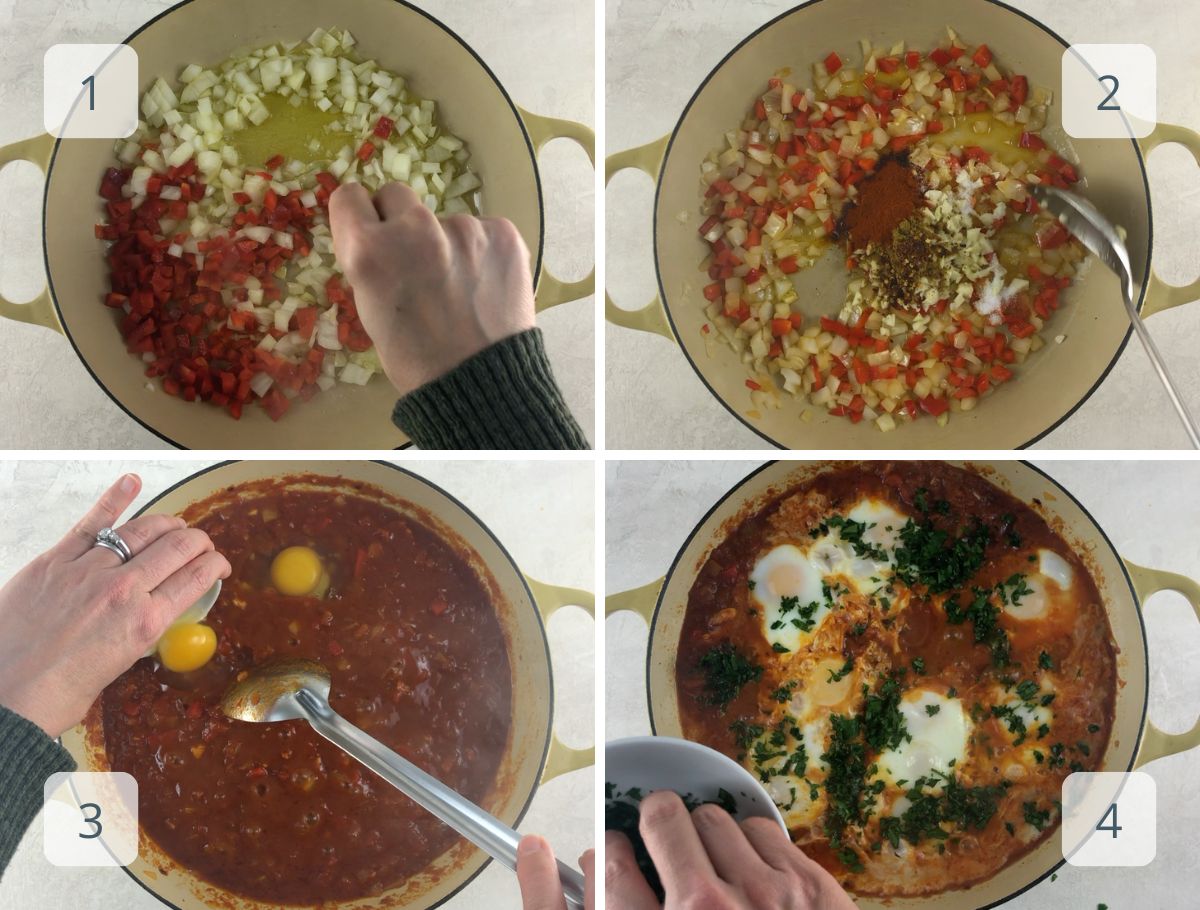
- First you’ll soften the onion and bell pepper in the olive oil.
- Stir in the spices and tomato sauce and simmer until slightly thickened. Stir in the feta.
- Make a divot for each egg and carefully lower it in. Cover the pan and simmer until whites are set to your liking.
- Sprinkle with parsley and serve. That’s it!
Expert tips and FAQs
Shakshuka is fabulous exactly as-is (and even without the feta, if you prefer). But it also takes beautifully to additions. My favorites are a few ounces of diced Spanish-style chorizo (which you can sauté along with the onion and pepper), a can chickpeas (drained, rinsed, and dried), or a can of black beans (same deal). If using beans, stir them in right before adding the eggs.
If you prefer, you can finish this dish in the oven. After nestling in the eggs, cover the pan and place in the center of a 400°F oven until eggs are set to your liking. This should take about the same amount of time as it does on the stovetop, maybe a little less. Start checking at the 5 minute mark.
If you want to get a head start, you can make the sauce well ahead of time and just reheat it to a simmer before dropping the eggs in. Leftovers store well tightly sealed in the fridge for about a week.
More favorite egg dishes
- Cast iron baked eggs, kale, and potatoes
- French baked eggs (oeufs en cocotte)
- Brussels sprouts hash with bacon and poached eggs
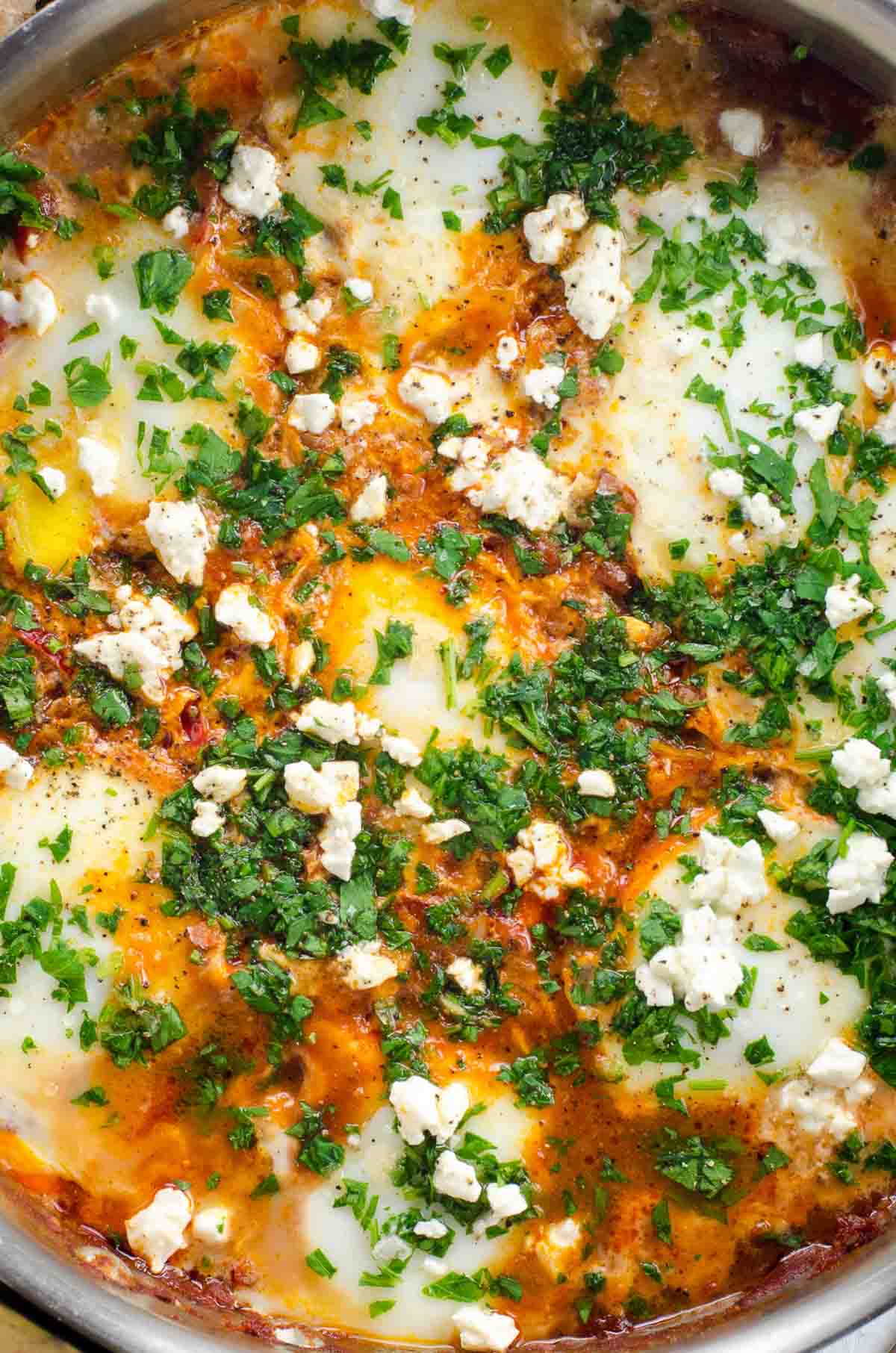
Hungry for more?
Subscribe to Umami Girl’s email updates, and follow along on Instagram.

Easy Shakshuka Recipe with Feta
Ingredients
- ¼ cup (60 ml) olive oil
- 1 large yellow onion, diced small
- 1 red bell pepper, diced small
- 1 teaspoon fine sea salt, divided
- ¼ teaspoon freshly ground black pepper
- 8 cloves garlic, chopped
- 1 teaspoon ground cumin
- 1 ½ teaspoons sweet Hungarian paprika
- ¼ teaspoon red pepper flakes
- 1 28- ounce 794-gram can diced tomatoes (with all their juices)
- 3 ounces (85 grams) feta cheese, crumbled
- 8 eggs
- ¼ cup chopped flat-leaf parsley or cilantro
- Crusty bread or pita for serving, optional
Instructions
- Heat the olive oil over medium heat in a heavy 12-inch frying pan with tall sides and a lid (which you'll use later).
- Add onion and red bell pepper along with half the salt and the freshly ground black pepper.
- Cook, stirring occasionally, for about five minutes, until somewhat tender.
- Add garlic, cumin, paprika, and red pepper flakes and cook, stirring frequently, two minutes more.
- Add tomatoes and remaining salt and simmer until slightly thickened, about 15 minutes.
- Stir in feta.
- Reduce heat to medium-low. Working one at a time, use a spoon to make a small well for each egg and crack egg into it.
- Cover pan and simmer for 10-15 minutes, until whites are set.
- Remove from heat and sprinkle with parsley or cilantro.
- Serve with crusty bread or pita, if you like.
Step-by-step video
Notes
- A good old yellow onion works great here, but this is not a fussy recipe. You can swap in a red onion or a couple of shallots if that's what you've got on hand. Dice it nice and small so it almost melts into the sauce. I aim for 1/4-inch (smaller for shallots).
- You can use red, orange, or yellow bell pepper for this recipe. I like to use red when I have it, just because the color melts into the tomato sauce. Their flavors are basically indistinguishable. Dice the pepper nice and small, too.
- The recipe calls for a fair amount of garlic, and you can add more if you like — I often do. Chop it evenly but somewhat roughly (as opposed to mincing), so that it won't burn.
- The sauce packs a deep savory flavor from a combination of ground cumin, paprika, and red pepper flakes. As written, this recipe has a very mild heat. You can add more red pepper flakes to suit your preference.
- You can use one 28-ounce can or one 26.5-ounce box of diced tomatoes (sometimes sold as chopped tomatoes), including all their juices. Different brands vary in consistency — the liquid may be thinner or thicker. They'll all work just fine. If your brand is on the thicker side, you may want to simmer the sauce with a lid on to prevent further thickening, and perhaps even add a little bit of water before doing so. Simmer for the full time period regardless, so the flavors have a chance to bloom. The goal is to end up with a sauce thick enough to allow you to create divots for the eggs.
- Good-quality eggs with beautiful golden yolks make this recipe the best version of itself. How long to cook them is a matter of personal preference — keep in mind that they will continue to firm up a bit as they sit in the hot pan. I prefer the whites set and the yolks a bit runny.
- I like to use a mild, cow's milk feta that crumbles well and isn't too soft. In this case, you can add it to the sauce right before or right after you put in the eggs. With softer varieties, you may want to add them at the end, right before sprinkling on the herbs. You can leave the cheese out and still end up with a beautifully flavored dish. Or try substituting fresh goat cheese for another great variation.
- I like to use chopped fresh cilantro when we have it, for a big burst of freshness and flavor. Flat-leaf (Italian) parsley works well too, if you prefer. If I have scallions in the fridge, I'll often slice a couple and add them as well.
- Shakshuka is fabulous exactly as-is (and even without the feta, if you prefer). But it also takes beautifully to additions. My favorites are a few ounces of diced Spanish-style chorizo (which you can sauté along with the onion and pepper), a can chickpeas (drained, rinsed, and dried), or a can of black beans (same deal). If using beans, stir them in right before adding the eggs.
- If you want to get a head start, you can make the sauce well ahead of time and just reheat it to a simmer before dropping the eggs in. Leftovers store well tightly sealed in the fridge for about a week.
- If you prefer, you can cook this dish, covered, in the center of a 400°F oven from step 8 forward (after cracking in the eggs). The eggs should set in 10-ish minutes there, too, maybe a little less. Start checking at the 5 minute mark.
Nutrition
Nutrition information is automatically calculated, so should only be used as an approximation.
Hungry for more?
Subscribe to Umami Girl’s email updates, and follow along on Instagram.


